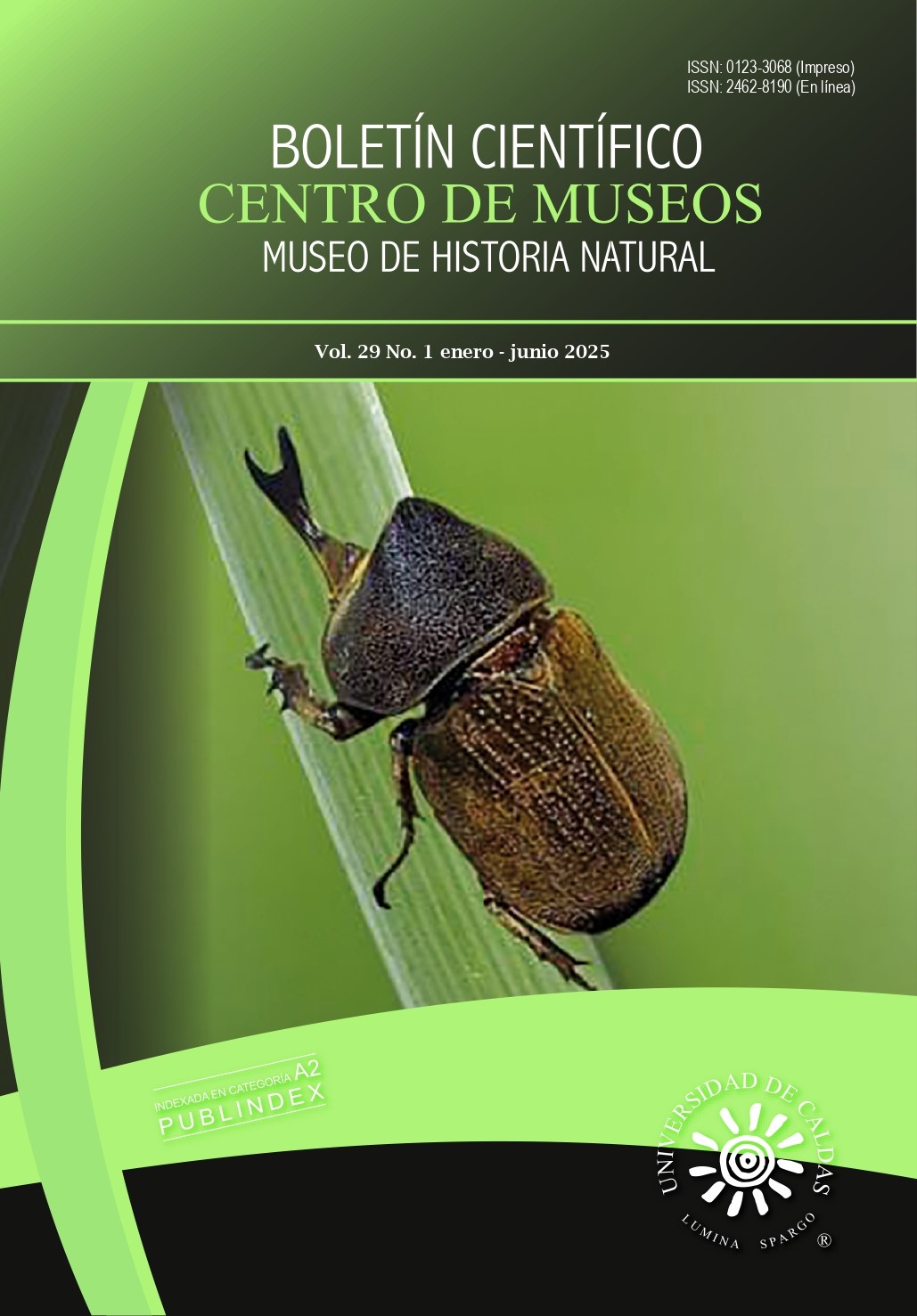Authors
Abstract
Some research has shown that polyphenols found in certain fruits have hypolipidemic properties when consumed in the diet and therefore this study aimed to present a review of the updated information on the hypolipidemic effect of Passiflora species. Several databases were used in the search for publications from the last 10 years (2013-2023) on advances in the use of Passiflora species for a complementary treatment of dyslipidemia. A total of 670 potential articles were found, of which 654 were excluded, leaving 16 articles for the review. Of the studies included in this analysis, 12 were on Passiflora edulis, eight were on the peel, three on the seed and one on the mesocarp. The other articles were on Passiflora species (P.incarnata, P. ligularis, P. foetida and P. nitida). Six were in humans, nine in mice and one study was conducted in rabbits. Metabolic syndrome was found to be the most addressed topic in this review, with a total of five studies, followed by the combination of overweight and dyslipidemia. The different parts of the Passiflora species studied showed a hypolipidemic effect and Passiflora edulis (passion fruit) is the most studied, with twelve studies. This effect is probably due to its content of polyphenols, fiber and bioactive compounds that reduce oxidative stress and chronic inflammation underlying various dyslipidemias. However, further studies in humans are needed to confirm these beneficial effects and to establish the doses and time required to obtain a positive result.
Keywords
References
Angel-Isaza, J., Carmona-Hernandez, J. C., Narváez-Solarte, W., & Gonzalez-Correa, C. H. (2021). Polyphenols from Passiflora ligularis Regulate Inflammatory Markers and Weight Gain. Biomolecular Concepts, 12(1), 36–45. https://doi.org/10.1515/bmc-2021-0005
Chalé, F. H., Ancona, D. B., & Campos, M. R. S. (2014). Compuestos bioactivos de la dieta con potencial en la prevención de patologías relacionadas con sobrepeso y obesidad; péptidos biológicamente activos. Nutricion Hospitalaria, 29(1), 10–20. https://doi.org/10.3305/nh.2014.29.1.6990
Cumpston, M. S., McKenzie, J. E., Welch, V. A., & Brennan, S. E. (2022). Strengthening systematic reviews in public health: guidance in the Cochrane Handbook for Systematic Reviews of Interventions, 2nd edition. Journal of Public Health (United Kingdom), 44(4), E588–E592. https://doi.org/10.1093/pubmed/fdac036
Da Silva, J. K., Cazarin, C. B. B., Batista, Â. G., & Maróstica, M. (2014). Effects of passion fruit (Passiflora edulis) byproduct intake in antioxidant status of Wistar rats tissues. Lwt, 59(2P2), 1213–1219. https://doi.org/10.1016/j.lwt.2014.06.060
Da Silva, J. K., Cazarin, C. B. B., Batista, Â. G., & Maróstica, M. (2014). Effects of passion fruit (Passiflora edulis) byproduct intake in antioxidant status of Wistar rats tissues. Lwt, 59(2P2), 1213–1219. https://doi.org/10.1016/j.lwt.2014.06.060
De Faveri, A., De Faveri, R., Broering, M. F., Bousfield, I. T., Goss, M. J., Muller, S. P., Pereira, R. O., de Oliveira e Silva, A. M., Machado, I. D., Quintão, N. L. M., & Santin, J. R. (2020). Effects of passion fruit peel flour (Passiflora edulis f. flavicarpa O. Deg.) in cafeteria diet-induced metabolic disorders. Journal of Ethnopharmacology, 250(December 2019). https://doi.org/10.1016/j.jep.2019.112482
Foster, B. C., Arnason, J. T., & Briggs, C. J. (2005). Natural health products and drug disposition. Annual Review of Pharmacology and Toxicology, 45, 203–226. https://doi.org/10.1146/annurev.pharmtox.45.120403.095950
Grosseli, M., Moraes, M., Damaceno, B., Okawabata, F., Tardivo, A., & Alves, M. (2014). Uso da polpa e da casca do maracujá (Passiflora edulis f.flavicarpa) sobre o colesterol em coelhos com hipercolesterolemia experimental. Revista de Pesquisa e Inovação Farmacêutica, 12–20.
Khongrum, J., Yingthongchai, P., Boonyapranai, K., Wongtanasarasin, W., Donrung, N., Sukketsiri, W., Prachansuwan, A., & Chonpathompikunlert, P. (2022). Antidyslipidemic, Antioxidant, and Anti-inflammatory Effects of Jelly Drink Containing Polyphenol-Rich Roselle Calyces Extract and Passion Fruit Juice with Pulp in Adults with Dyslipidemia: A Randomized, Double-Blind, Placebo-Controlled Trial. Oxidative Medicine and Cellular Longevity, 2022. https://doi.org/10.1155/2022/4631983
Kitada, M., Ogura, Y., Maruki-Uchida, H., Sai, M., Suzuki, T., Kanasaki, K., Hara, Y., Seto, H., Kuroshima, Y., Monno, I., & Koya, D. (2017). The Effect of Piceatannol from Passion Fruit (Passiflora edulis) Seeds on Metabolic Health in Humans. Nutrients, 9(10), 1142. https://doi.org/10.3390/nu9101142
Leal, A. E. B. P., de Oliveira, A. P., dos Santos, R. F., Soares, J. M. D., de Lavor, E. M., Pontes, M. C., de Lima, J. T., da Conceição Santos,A. D., Tomaz, J. C., de Oliveira, G. G., Neto, F. C., Lopes, N. P., Rolim, L. A., & da Silva Almeida, J. R. G. (2020). Determination of phenolic compounds, in vitro antioxidant activity and characterization of secondary metabolites in different parts of Passiflora cincinnata by HPLC-DAD-MS/MS analysis. Natural Product Research, 34(7), 1–7. https://doi.org/10.1080/14786419.2018.1548445
Marques, S. do S. F., Libonati, R. M. F., Sabaa-Srur, A. U. O., Luo, R., Shejwalkar, P., Hara, K., Dobbs, T., & Smith, R. E. (2016). Evaluation of the effects of passion fruit peel flour (Passiflora edulis fo.flavicarpa) on metabolic changes in HIV patients with lipodystrophy syndrome secondary to antiretroviral therapy. Revista Brasileira de Farmacognosia, 26(4), 420–426. https://doi.org/10.1016/j.bjp.2016.03.002
Mendis, S., Puska, P., Norrving, B., Organization, W. H., Federation, W. H., & Organization, W. S. (n.d.). Global atlas on cardiovascular disease prevention and control / edited by: Shanthi Mendis ... [et al.]. World Health Organization. https://apps.who.int/iris/handle/10665/44701
Neves Casarotti, S., Fernanda Borgonovi, T., de Mello Tieghi, T., Sivieri, K., & Lúcia Barretto Penna, A. (2020). Probiotic lowfat fermented goat milk with passion fruit by-product: In vitro effect on obese individuals’ microbiota and on metabolites production. Food Research International, 136(September 2019), 109453. https://doi.org/10.1016/j.foodres.2020.109453
Nikolova, K., Velikova, M., Gentscheva, G., Gerasimova, A., Slavov, P., Harbaliev, N., Makedonski, L., Buhalova, D., Petkova, N., & Gavrilova, A. (2024). Chemical Compositions, Pharmacological Properties and Medicinal Effects of Genus Passiflora L.: A Review. Plants, 13(2). https://doi.org/10.3390/plants13020228
Organization, W. H. (n.d.). 2008-2013 action plan for the global strategy for the prevention and control of noncommunicable diseases: prevent and control cardiovascular diseases, cancers, chronic respiratory diseases and diabetes. World Health Organization. https://apps.who.int/iris/handle/10665/44009
Organization, W. H. (2023). Cardiovascular Diseases. 20 November 2023. https://www.who.int/health-topics/cardiovascular-diseases#tab=tab_1
Panelli, M. F., Pierine, D. T., de Souza, S. L. B., Ferron, A. J. T., Garcia, J. L., dos Santos, K. C., Belin, M. A. F., Lima, G. P. P., Borguini, M. G., Minatel, I. O., Cicogna, A. C., Francisqueti, F. V., & Corrêa, C. R. (2018). Bark of Passiflora edulis Treatment Stimulates Antioxidant Capacity, and Reduces Dyslipidemia and Body Fat in db/db Mice. Antioxidants, 7(9), 120. https://doi.org/10.3390/antiox7090120
Pineda-Lozano, J. E., López-Espinoza, A., Virgen-Carrillo, C. A., Martínez-Moreno, A. G., & Valdés-Miramontes, E. H. (2021). Effect of phenolic compounds on human dyslipidemic disorders: A systematic review. Revista Chilena de Nutricion, 48(2), 276–285. https://doi.org/10.4067/S0717-75182021000200276
Ravi Babu Birudu, M. Jagadish Naik, & Janardhan M. (2015). Anti-Dyslipidemia Effect of Ethanol Extract of Passiflora foetida on Dextrose Induced Diabetic Rats. Pharmaceutical and Biosciences Journal, Februarld, 13–19. https://doi.org/10.20510/ukjpb/4/i1/87840
Sarto, D. A. Q. S., de Siqueira, A. H. D., de Almeida Magalhaes, F. M., de Paula Caproni, K., Martins, Â. M., Santos, G. B., da Silva, D. B., Boas, B. M. V., & Garcia, J. A. D. (2018). Dry Extract Of Passiflora Incarnata L. Leaves As A Cardiac And Hepatic Oxidative Stress Protector In Ldlr-/-Mice Fed High-Fat Diet. Brazilian Archives of Biology and Technology, 61, 1–10. https://doi.org/10.1590/1678-4324-2018180147
Sousa, D. F. de, Araújo, M. F. M. de, de Mello, V. D., Damasceno, M. M. C., & Freitas, R. W. J. F. de. (2021). Cost-Effectiveness of Passion Fruit Albedo versus Turmeric in the Glycemic and Lipaemic Control of People with Type 2 Diabetes: Randomized Clinical Trial. Journal of the American College of Nutrition, 40(8), 679–688. https://doi.org/10.1080/07315724.2020.1823909
Takam, P. N., Djikeng, F. T., Kuate, D., Kengne, A. P. N., Tsafack, H. D., Makamwé, I., & Oben, J. E. (2019). Passiflora edulis seed oil from west Cameroon: Chemical characterization and assessment of its hypolipidemic effect in high‐fat diet–induced rats. Food Science & Nutrition, 7(11), 3751–3758. https://doi.org/10.1002/fsn3.1234
Teixeira, L. S., Lima, A. S., Boleti, A. P. A., Lima, A. A. N., Libório, S. T., de Paula, L., Oliveira, M. I. B., Lima, E. F., Costa, G. M., Reginatto, F. H., & Lima, E. S. (2014). Effects of Passiflora nitida Kunth leaf extract on digestive enzymes and high caloric diet in rats. Journal of Natural Medicines, 68(2), 316–325. https://doi.org/10.1007/s11418-013-0800-1
Virani, S. S., Alonso, A., Benjamin, E. J., Bittencourt, M. S., Callaway, C. W., Carson, A. P., Chamberlain, A. M., Chang, A. R., Cheng, S., Delling, F. N., Djousse, L., Elkind, M. S. V., Ferguson, J. F., Fornage, M., Khan, S. S., Kissela, B. M., Knutson, K. L., Kwan, T. W., Lackland, D. T., … Tsao, C. W. (2020). Heart disease and stroke statistics—2020 update a report from the American Heart Association. In Circulation (Vol. 141, Issue 9). https://doi.org/10.1161/CIR.0000000000000757
Vuolo, M. M., Lima, G. C., Batista, Â. G., Carazin, C. B. B., Cintra, D. E., Prado, M. A., & Júnior, M. R. M. (2020). Passion fruit peel intake decreases inflammatory response and reverts lipid peroxidation and adiposity in diet-induced obese rats. Nutrition Research, 76, 106–117. https://doi.org/10.1016/j.nutres.2019.08.007
Yepes-Nuñez, J. J., Urrútia, G., Romero-García, M., & Alonso-Fernández, S. (2021). The PRISMA 2020 statement: an updated guideline for reporting systematic reviews. Revista Espanola de Cardiologia, 74(9), 790–799. https://doi.org/10.1016/j.recesp.2021.06.016

 PDF
PDF
 FLIP
FLIP






















